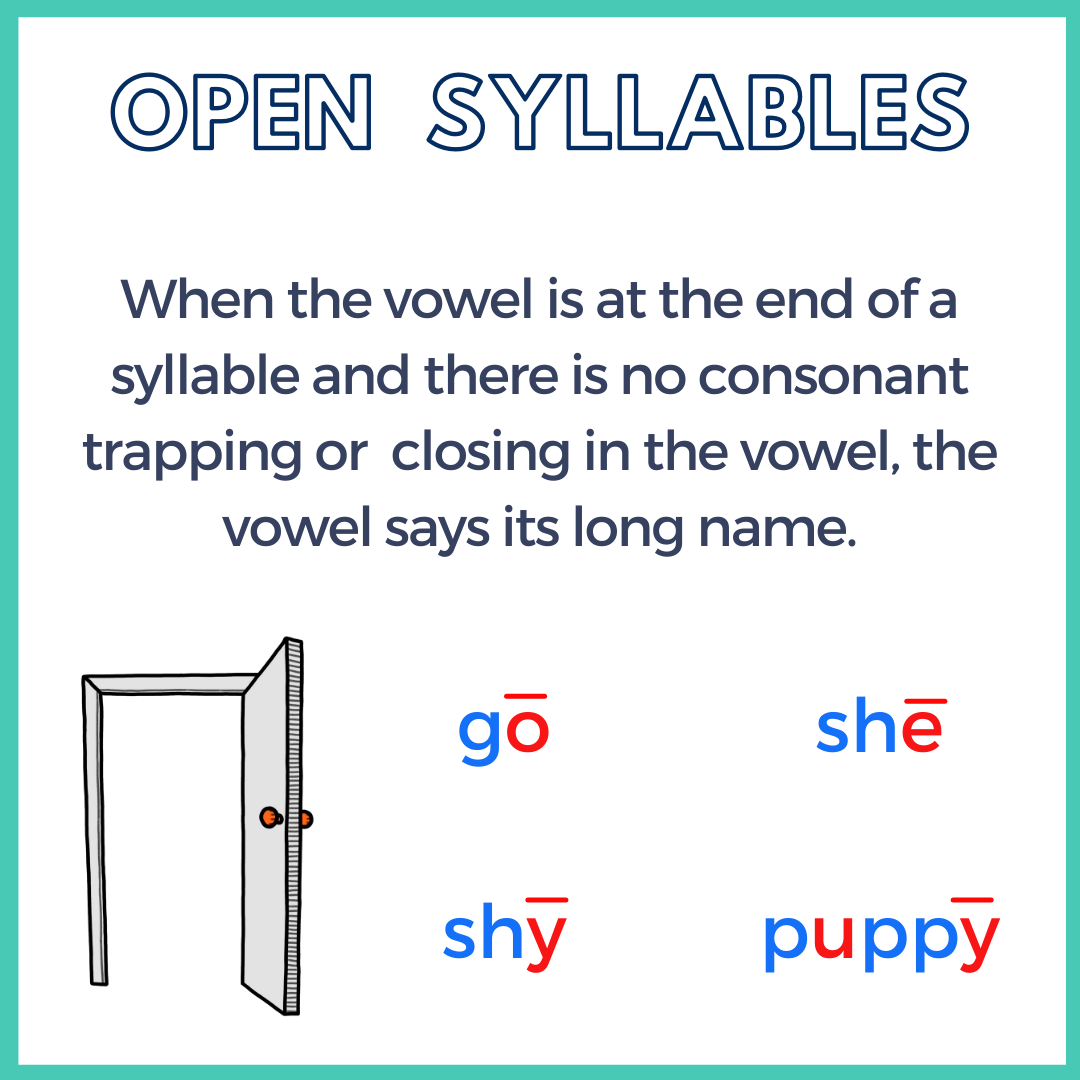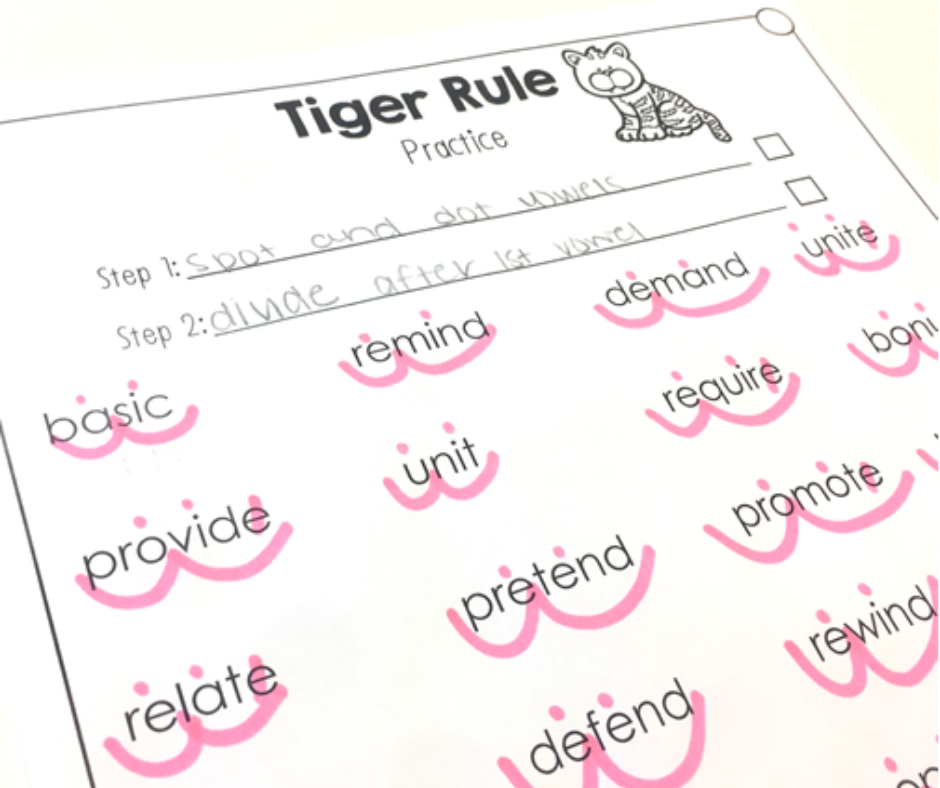Understanding the Six Syllable Types - Open Syllables
If you’ve been hanging out with us through the Understanding the Six Syllable Types series, you know what we’re about to say here! One of the most effective practices used in evidence-based reading instruction is the process of teaching each of the syllable types and syllable division patterns.
If you have never heard of the six syllable types, don't worry - you are not alone. Check out our blog: What’s This About the Six Syllable Types.
We’re going to run through the background again, just in case some of you are just joining us!
Why teach the six syllable types?
Understanding the syllable types helps students anticipate the vowel sounds within a word. It also helps students learn to break or chunk words effectively to sound out longer words.
The Science of Reading has provided a great deal of information on the most effective, evidence-based practices in teaching reading. Teaching the six syllable types aligns with the explicit teaching of concepts. So specifically, we teach:
What is a Syllable?
A syllable is a word or part of a word with one vowel sound. Understanding this definition can help us to read and spell effectively.
As we work with students we also want to follow a systematic progression of concepts. Systematic phonics-based instruction is well-researched and has been proven to help children learn to read better than all forms of control group instruction including whole language based on quantitative meta-analyses (Ehri, L. C., Nunes, S. R., Stahl, S. A., & Willows, D. M. 2001).
A systematic progression means working from the most basic concepts and progressing to more complex concepts while continuing to systematically review the concepts taught earlier in the progression. Now, it’s important to note that our systematic progression of concepts is not necessarily the same as others - this is okay. It’s all about using a hierarchy and order of teaching that generally provides students with access to the tools they need as quickly as possible to be able to read as many words as possible.
We continue our syllable type instruction with open syllables. You can find more information on the other syllable types here:
What is an Open Syllable?
An open syllable is a syllable that ends with a vowel. When the vowel is at the end of the syllable and there is no consonant trapping or closing in the vowel, the vowel says its long sound (its name).
Let’s use the word “go” as an example.
This is a one-syllable word. The syllable ends with a vowel. Since the vowel is not closed in or trapped by a consonant, the vowel says its long sound. However, if we added a ‘t’ and the word became “got,” the vowel is now trapped, making it a closed syllable. The vowel, in this case, would then make its short sound.
How do I teach Open Syllables?
It can be fun to use stories or visuals to help teach the concept of open syllables. This also can help reinforce the concept of closed syllables. Stories and visuals can help anchor concepts for students. We like to use the visual of a door that is open.
You can pair these visuals with stories as appropriate. For example, vowels LOVE saying their name. They enjoy talking about themselves. When they’re trapped in their house, they’re stuck saying their short sound. However, if the backdoor gets left OPEN they can run out and scream their name.
After telling this story, you can use a whiteboard with the word go written on it. First, spot and dot the vowel. Then, put an outline of a door frame around the space behind the vowel, the letter “o.” Point out that the door is open since there isn’t a consonant following the vowel. There is no letter blocking the vowel.
Then, you can try another example with the open syllable word, “she.” Write the word “she” on the whiteboard, spot and dot the vowel, and draw the door frame around the space behind the vowel letter “e.” Ask, “Is this door open or closed?”
Guide the student to notice that the doorway is empty, there is no consonant letter in that doorway, there is not a letter closing in or trapping the vowel. Since there is not a consonant there, and the door is open, the vowel letter e is going to run out the door and shout its name /E/. We would sound out this word as /sh/ /E/.
Next, go back to a closed syllable and use a word like not. Spot and dot the vowel letter O and draw the door frame around the letter T since it is in the space behind the vowel. Then, ask, “Is this door open or closed?”
Guide the student to notice that since the letter t is in the doorway, the door isn’t open, it is closed. The consonant letter t is trapping the vowel letter “o” and it can’t get out and shout its name. It’s stuck and can only say its short sound of /o/. Therefore, we sound out this word as /n/ /o/ /t/. However, if we removed the T we would get an open syllable “no” or if we added an E to the end of “not” we would get a VCE syllable and create “note.”
Even as students become more proficient with this concept, have them spot and dot their vowels. Drawing attention to that vowel is what will cue them to notice what follows the vowel. Continue drawing the door frame behind the vowel until you are ready to gradually release students to notice this syllable type without the prompt of the door frame. This varies for each student.
What about words with more than one syllable?
In a multi-syllable word, you may have an open syllable and a closed syllable together. Or an open syllable paired with another syllable type. Let’s look at the word robot. First, this is a two-syllable word. Guide students in dividing or scooping the two syllables to break the word into two smaller chunks ro – bot.
After spotting and dotting the vowels, we can look closely at the first syllable ro. Notice that the syllable ends with a vowel, the letter o. It is important that the syllable is isolated at this point so that students see we are looking at the syllable, not the word.
When we look at the word as a whole, it looks like the consonant letter b is closing in or trapping the vowel. It’s only when we break the word into syllables that students see the vowel isn’t trapped or closed in, it is the last letter in the first syllable. Since there is no consonant behind it, the syllable is open. The vowel can now shout its name /O/.
The second syllable is bot. If we spot and dot the vowel, we notice that the consonant letter t is following the “o” or closing it in therefore the vowel can’t get out, it’s trapped, and can only say its short sound of /o/ as in otter.
The word “robot” is an example of a multi-syllable word that has both an open and a closed syllable.
To grab this Open Syllable Game & hundreds of other activities to support phonics and the other core components of literacy, check out our resource library >>here.<<
So, how do I actually implement open-syllable practice into my lessons?
After explicitly teaching the open syllable rules, it is important that students are able to apply their knowledge and practice! We love “gamifying” our word lists to make them more fun and engaging for students. If you laminate your word lists, you can have students use dry-erase markers to find their vowels and divide their words again and again!
Again, providing this framework for students provides them with that light-bulb aha moment that we as educators are always looking for.
WANT TO LEARN MORE?
Helping students understand the syllable types is one of the most effective ways to support reading and SPELLING development. If you want to begin using some fun new materials and/or continue your learning about syllable types and the science of reading, then use the buttons below!
Grab games that support syllable type learning
Decks for all types!
What is the Science of Reading all about?
Grab our Science of Reading Blueprint!









